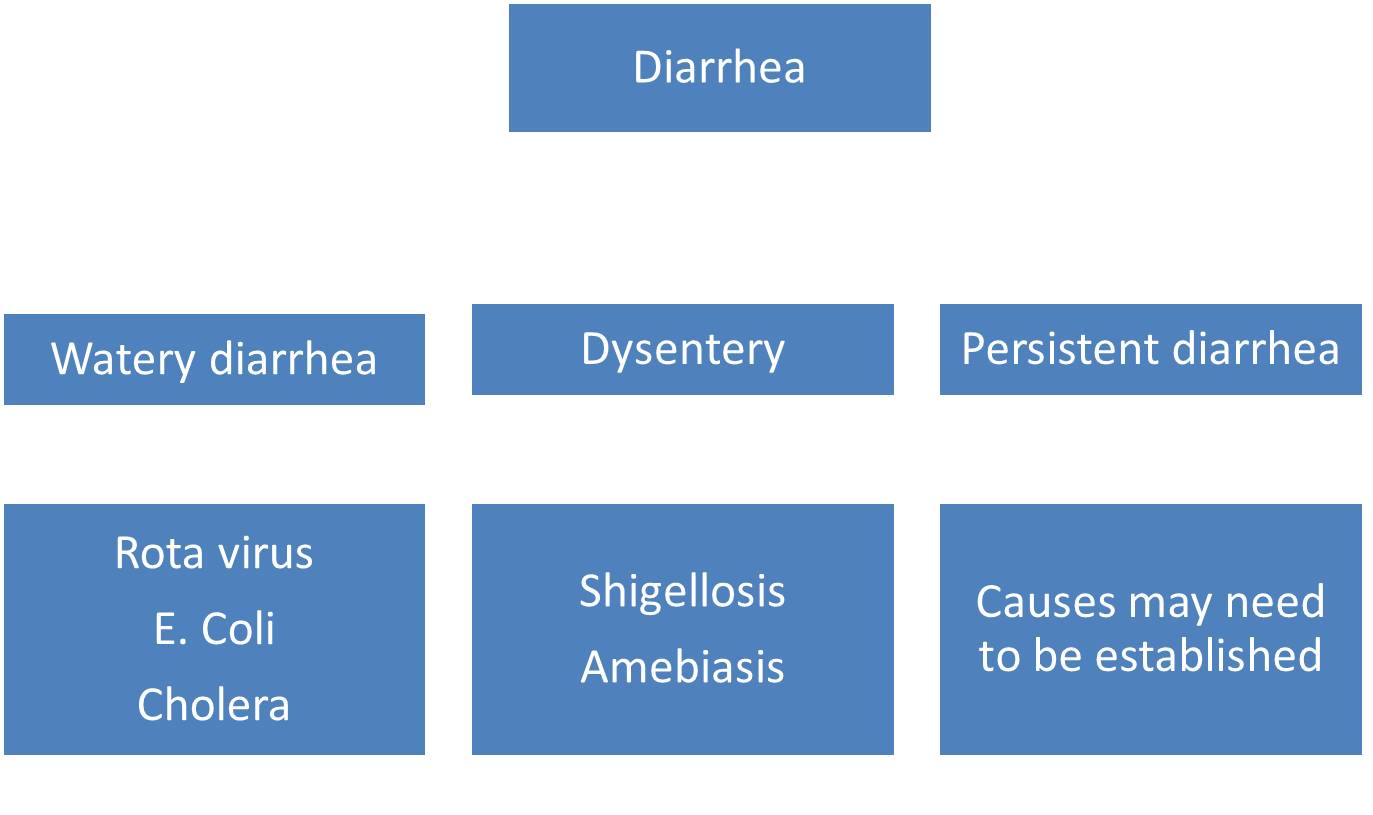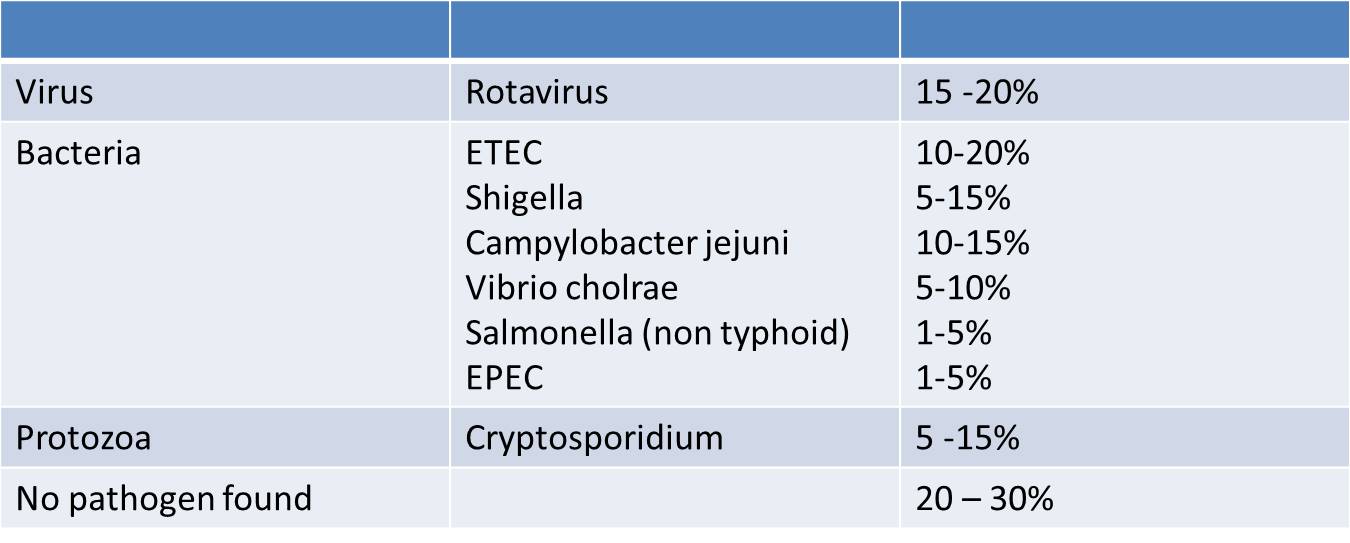• Major killer of under 5 children, even though the toll has reduced considerably
– 10% of under-5 deaths in India
– Reduction of mortality mainly due to rehydration tech including ORS
• Under 5 children are estimated to have 3 episodes per year
– Incidence hasn’t changed much but mortality is reduced considerably
– Loss of considerable number of DALYs
• Leading cause of death during disasters and emergencies
– Displacement of population into temporary, overcrowded shelters and polluted water source, inadequate sanitation, contaminated food, lack of hygiene and malnutrition, all lead to spread and severity of diarrhea
• Heavy economic burden on:
– Health services and Nation
Definition: Recent change in consistency or number of stools
Four clinical types have been defined:
• Acute Watery Diarrhea: 3 or more liquid or watery stools in 24 h
– Main danger is dehydration
• Dysentery: Presence of blood and/or mucus in stools
– Main danger is injury to intestinal mucosa and sepsis
• Persistent Diarrhea: Diarrhea lasting for 14 days or more
– Main danger is malnutrition
– Persons with other diseases like AIDS are more likely to develop persistent diarrhoea
– Diarrhea associated with severe malnutrition
– Main danger is severe systemic sepsis (septicaemia)
Agent, host and environmental factors
Causes of Acute diarrhea
VIRUSES
• Rotavirus
– Leading cause of severe, dehydrating diarrhea in < 5
– In developing countries, three-quarters of children acquire their first episode of rotavirus diarrhoea before the age of 12 months, whereas
– in developed countries the first episode is frequently delayed until the age of 2-5 years.
– Severe rotavirus gastroenteritis is largely limited to children aged 6-24 months.
– Re-infection known but first one only is usually severe
– Highly infectious, shed in very high concentrations, difficult to control spread
• Even with clean water supplies and good hygiene practices
– Feco-oral route, person to person & via fomites
• Adenoviruses
• Caliciviruses
• Astroviruses
• Coronaviruses
• Norwalk agents and Norwalk-like viruses
BACTERIAL CAUSES
• Campylobacter jejuni
• Enterotoxigenic Escherichia coli
– ETEC is an important cause of acute watery diarrhoea in adults and children in developing countries
• Most common cause of traveller's diarrhoea.
• Two types of toxins, heat labile (LT) and heat stable (ST).
• Shigella
– Higher percentage of mortality
– Important cause among under 5
• Salmonella
– Cause inflammation of the bowel epithelium
• Campylobacter jejuni
– Slim, highly motile, S-shaped, gramnegative rods, formerly classed as vibrios.
– One of the commonest causes of enteritis, mechanism not known
• Vibrio cholera - Does not invade gut mucosa
• Vibrio parahemolyticus
• Bacillus cereus
• Staphylococcus aureus
• Clostridium perfringens
• Enterohemorrhagic E Coli
• Aeromonas
• Yersinia enterocolitica
• Chlamydia
• Neisseria gonorrhoeae
E. coli, Shigella and Salmonella produce potent enterotoxin similar to that of vibrio cholarae
PARASITES
• Entameba histolytica
• Giardia lamblia
It flourishes in duodenum and jejunum
Lumen teeming with very large numbers,
• Tichuriasis
• Cryptosporidium Spp.
Causes diarrhea in infants, immuno-deficient patients and some domestic animals
Diarrhea usually not severe or prolonged except in immuno-deficient sates like AIDS
• In these patients it’s a common cause of persistent diarrhea and leads to wasting
• Intestinal worms
• Cyclospora
PARENTERAL INFECTION ESP. IN CHILDREN
• ENT, respiratory
• Urinary
• Malaria
• Meningitis etc.
Apart from these, during or after measles, there is a high risk of severe or fatal diarrhea
OTHER CAUSES
•Metabolic disease
Hyperthyroidism
Diabetes mellitus
Pancreatic insufficiency
•Food allergy
Lactose intolerance
• Antibiotics
• Irritable bowel syndrome
• Parenteral Diarrhea – particularly in young children
ENT, respiratory, urinary, infections malaria, meningitis
Until recently the pathogen could be identified only 25% of diarrhea cases
Currently, new techniques have enabled such identification in 75% cases
Causes in Developing Countries
Reservoir of Infection
• Human is principal reservoir for:
• V. cholerae, Giardia lamblia and E. histolytica
• Both man and animals are the reservoir for:
• Campylobacter jejuni, salmonella spp. and Y. enterocolitica
Host Factors
• Most common in children esp. b/w 6months – 2 years age
– Highest incidence between 6 – 11 months age
• This may be due to:
– Declining maternal antibodies
– Introduction of complimentary feed
– Crawling
• More common in the
– bottle fed
– malnourished
• Malnutrition leading to diarrhea and vice versa forms a vicious cycle
ENVIRONMENTAL FACTORS
risk factors are:
– Poverty
– Unhygienic conditions
– Prematurity
– Reduced gastric acid
– immunodeficiency
Seasonal patterns differ in geographical areas
• Tropical areas:
– Rotavirus occurs throughout the year but increase in winter and
– Bacterial diarrheas peak during the warmer rainy season
• Temperate climate:
– Bacterial diarrheas more frequent in warm season and
– Viral diarrheas in winters
Transmission
• Most of the diarrheal agents are transmitted by the fecal-oral route
• Water – borne
• Food – borne
• Person to person transmission via finger or fomite
• Some viruses (such as rotavirus) can be transmitted through air
• Nosocomial transmission is possible
Reference:
K. Park, 2019. Epidemiology of Communicable Diseases, In: Park’s Textbook of Preventive and Social Medicine, 25th ed. Jabalpur, 2019
Clinical features suggestive of dehydration: http://www.ihatepsm.com/blog/clinical-features-suggestive-dehydration
ORAL REHYDRATION SALT (ORS): http://www.ihatepsm.com/blog/oral-rehydration-salt-ors
Management of Acute Diarrhoea in Children: http://www.ihatepsm.com/blog/management-acute-diarrhoea-children
4 Rules of Home Treatment for Diarrhea in Children: http://www.ihatepsm.com/blog/4-rules-home-treatment-diarrhea-children
Sugar Salt Solution for Rehydration: http://www.ihatepsm.com/blog/sugar-salt-solution-rehydration
6 Steps of ‘Skin Pinch’ Test for Assessing Dehydration: http://www.ihatepsm.com/blog/6-steps-%E2%80%98skin-pinch%E2%80%99-test-a...
Some Clinical features of diarrhea due to common causative organisms: http://www.ihatepsm.com/blog/some-clinical-features-diarrhea-due-common-...
Principles of management of diarrhea: http://www.ihatepsm.com/blog/principles-management-diarrhea
Control of diarrheal diseases: http://www.ihatepsm.com/blog/control-diarrheal-diseases
Indicators of Diarrhea Control: http://www.ihatepsm.com/blog/indicators-diarrhea-control
Lecture on acute diarrheal disaeses-1 (epidemiology): https://www.youtube.com/watch?v=8VMSn7mJgm8&t=215s
Lecture on acute diarrheal disaeses-2 (control): https://www.youtube.com/watch?v=85iOg3GNevU&t=41s
Lecture (HINDI) on acute diarrheal disaeses-1 (epidemiology): https://www.youtube.com/watch?v=c-bOaC55u-g&t=5s
Lecture (HINDI) on acute diarrheal disaeses-2 (control): https://www.youtube.com/watch?v=acc-nqkjar4&t=1s
